Are you trying to import a Postman collection into Bruno and hitting a wall? You’re not alone! The frustration is real when you’re all set to get things done, and suddenly, the process comes to a screeching halt. But don't worry, we're here to help you troubleshoot this issue and get you back on track.
Now, let’s get to the root of the issue.
Understanding the Bruno-Postman Relationship
Before jumping into the possible reasons behind the import failure, it's essential to understand the relationship between Bruno and Postman. Both tools are designed to make API testing easier, but they have different ways of handling collections, variables, and environments.
- Postman: A well-established API development environment that allows you to create, test, and share APIs with your team.
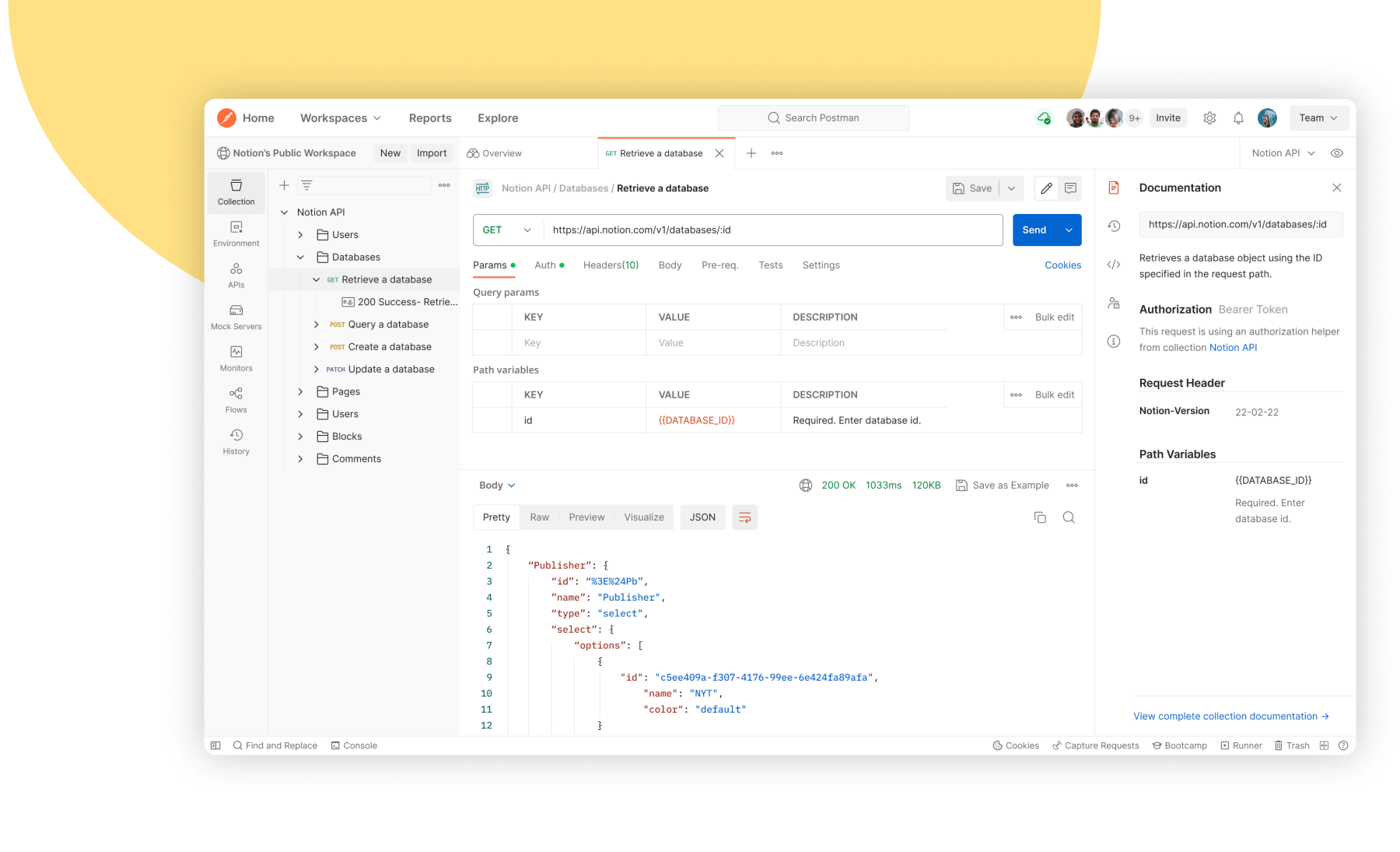
- Bruno: A relatively newer tool that aims to simplify API testing even further, especially for developers who prefer a minimalistic approach.

These tools, while similar in purpose, handle data structures differently. This difference can sometimes lead to compatibility issues when importing a Postman collection into Bruno.
Why the Import Might Fail
Here are some of the most common reasons your Postman collection might fail to import into Bruno:
1. Compatibility Issues
Not all versions of Postman collections are compatible with Bruno. Postman collections have undergone several updates over the years, and some of these updates may not be fully supported by Bruno yet.
- Postman Collection Versions: Postman uses versioning for its collections (e.g., v1, v2, v2.1). If your collection was exported from a newer version of Postman that Bruno doesn't support, the import could fail.
- Data Structures: Bruno might have trouble recognizing certain data structures or elements that Postman uses, especially if they’re specific to the latest versions.
2. Large or Complex Collections
Another common issue is the size and complexity of the collection you’re trying to import. Large collections with multiple folders, environments, and variables can be overwhelming for Bruno, leading to a failed import.
- Memory Constraints: Bruno might not have the same memory handling capabilities as Postman, causing it to struggle with large collections.
- Complex Hierarchies: Collections with deeply nested folders and requests can create complications during import, as Bruno might not interpret the hierarchy correctly.
3. Incorrect File Format
Sometimes, the issue is as simple as trying to import the wrong file format. Postman collections are typically exported in JSON format, but if the file was altered or saved incorrectly, Bruno may not be able to process it.
- Corrupted Files: If the JSON file is corrupted or has syntax errors, the import will likely fail.
- Unsupported Formats: Make sure that the file you're importing is in a format that Bruno recognizes.
4. Bruno's Limitations
As a newer tool, Bruno might have some inherent limitations compared to a more mature tool like Postman.
- Feature Gaps: Bruno may lack certain features that Postman has, leading to potential compatibility issues during import.
- Ongoing Development: Bruno is still evolving, which means there might be bugs or unimplemented features that could cause import failures.
5. Configuration Mismatches
Configuration mismatches between Postman and Bruno can also be a culprit. If the environments or variables are set up differently in Bruno, the collection might not import as expected.
- Environment Variables: If Postman collections rely heavily on environment variables that don’t exist in Bruno, the import could fail or result in errors.
- Request Configurations: Specific configurations, such as request timeouts or authentication settings, might not translate well from Postman to Bruno.
How to Troubleshoot and Fix the Issue
Now that we’ve covered the potential reasons for the import failure, let’s explore some ways to troubleshoot and fix the issue.
1. Check Postman Collection Version
First things first, check the version of the Postman collection you’re trying to import.
- Export a Compatible Version: When exporting your collection from Postman, make sure to select a version that Bruno supports (e.g., v2 or v2.1). You can usually find this option in the export dialog within Postman.
- Update Bruno: Ensure that you’re using the latest version of Bruno, as updates might have added support for newer Postman collection versions.
2. Simplify the Collection
If the collection is large or complex, consider simplifying it before importing it into Bruno.
- Break Down the Collection: Split the collection into smaller, more manageable parts. For instance, you can create separate collections for different API endpoints or environments.
- Reduce Nested Folders: Flatten out the folder structure to minimize the hierarchy and make it easier for Bruno to process.
3. Validate the JSON File
Make sure the JSON file is in good shape before attempting to import it into Bruno.
- Use a JSON Validator: Run the file through a JSON validator to check for any syntax errors or corruption. This simple step can save you a lot of time.
- Export Again: If the file seems corrupted, try exporting the collection from Postman again. Sometimes, a fresh export can resolve hidden issues.
4. Adjust Bruno Settings
Sometimes, tweaking Bruno’s settings can help it better handle the import.
- Increase Memory Allocation: If possible, allocate more memory to Bruno to help it process larger collections.
- Check for Beta Features: Bruno might have beta features or plugins that can improve compatibility with Postman collections. Check the documentation or forums for any relevant tips.
5. Manually Recreate the Collection
If all else fails, you might need to manually recreate the collection in Bruno.
- Import Individual Requests: Instead of importing the entire collection, try importing individual requests one by one. This can help identify the specific request or part of the collection causing the issue.
- Manually Set Up Environments: Recreate the necessary environments and variables in Bruno to ensure that everything is configured correctly.
Why Apidog is a Better Alternative
Now, let’s circle back to what we discussed earlier. Postman’s gradual shift away from free-tier users has left many feeling squeezed—frustrated with the limitations imposed to nudge them into paid plans. This shift is a critical pain point, especially when you’re dealing with issues like import failures in Bruno.

That’s where Apidog steps in as a much better alternative. Unlike Postman, Apidog remains committed to supporting all users, regardless of whether they’re on a free or paid plan. With Apidog, you get:
- Uncompromised Features: Even on the free tier, Apidog offers robust features that don’t push you towards a paid plan.
- User-Friendly Interface: Apidog’s interface is designed to be intuitive, making it easy to switch from other tools.
- No Pressure: You won’t feel squeezed into paying for features you don’t need.
If you’re tired of Postman’s tactics and want an API tool that values you as a user, download Apidog for free and see how it can simplify your workflow.
Import Data into Postman
When your team is using Postman and needs to transfer data or share project configurations, you can easily import data previously exported from Postman, including collections, environments, data dumps, and globals.
Postman automatically recognizes Postman-specific data during the import process, simplifying the entire workflow.
Step 1. Open Postman and navigate to the Collections tab on the left-hand side. Click on the "Import" button located in the top-left corner of the screen.

Step 2. In the "Import File" modal, click on the "Choose Files" button and select the Postman collection file you need to import. Or you can
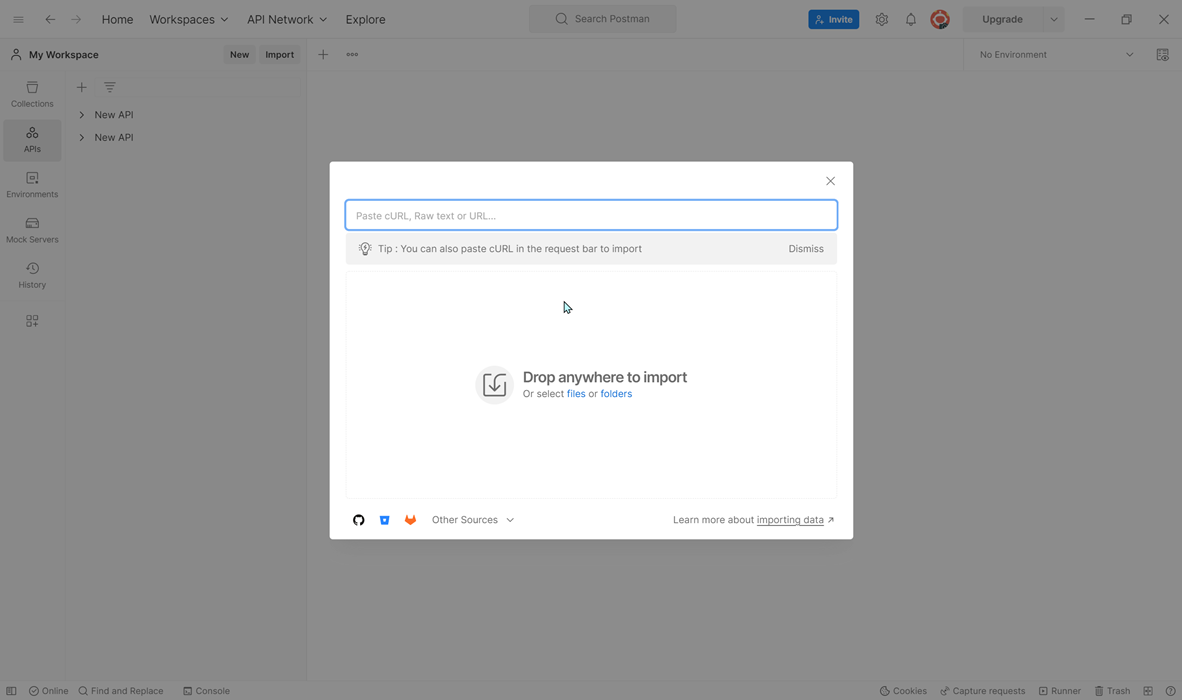
Step 3. Once the file has been selected, click on the "Import" button to initiate the import process.
Step 4. After the import process is complete, you should see your newly imported collection listed in the Collections tab.
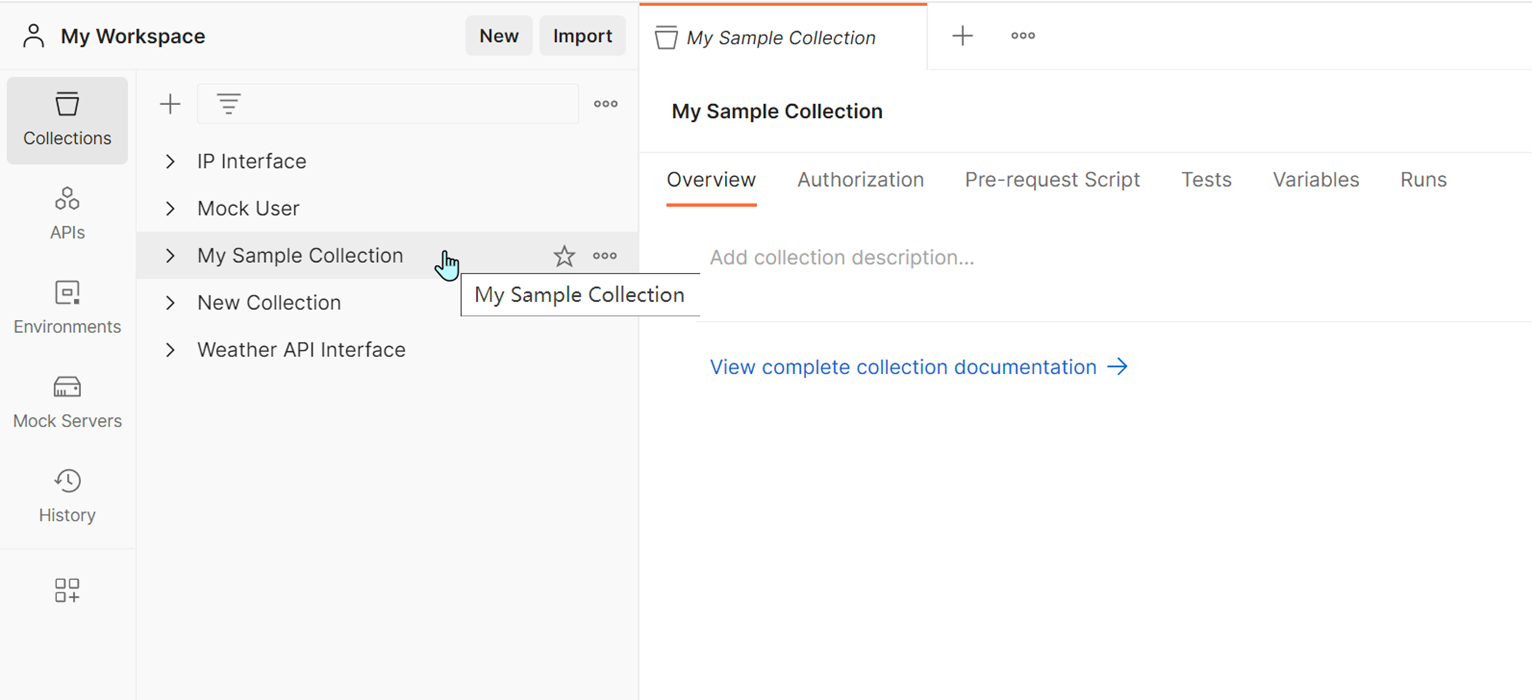
Postman's new plans restrict Free and Basic users to 25 runs/month, with 250 for Professional and unlimited for Enterprise. Frustrated by these limits on running local collections, many developers are switching to other API tools. If you're in the same boat, let's move on to export the data from data to local.
Export Postman All Collections
Step 1. Open Postman and navigate to the collection you want to export. Click on the ellipsis (...) icon next to the collection name.

Step 2. Select "Export" from the drop-down menu. Choose the format in which you want to export the collection. Postman supports a variety of formats including JSON, CSV, and YAML.
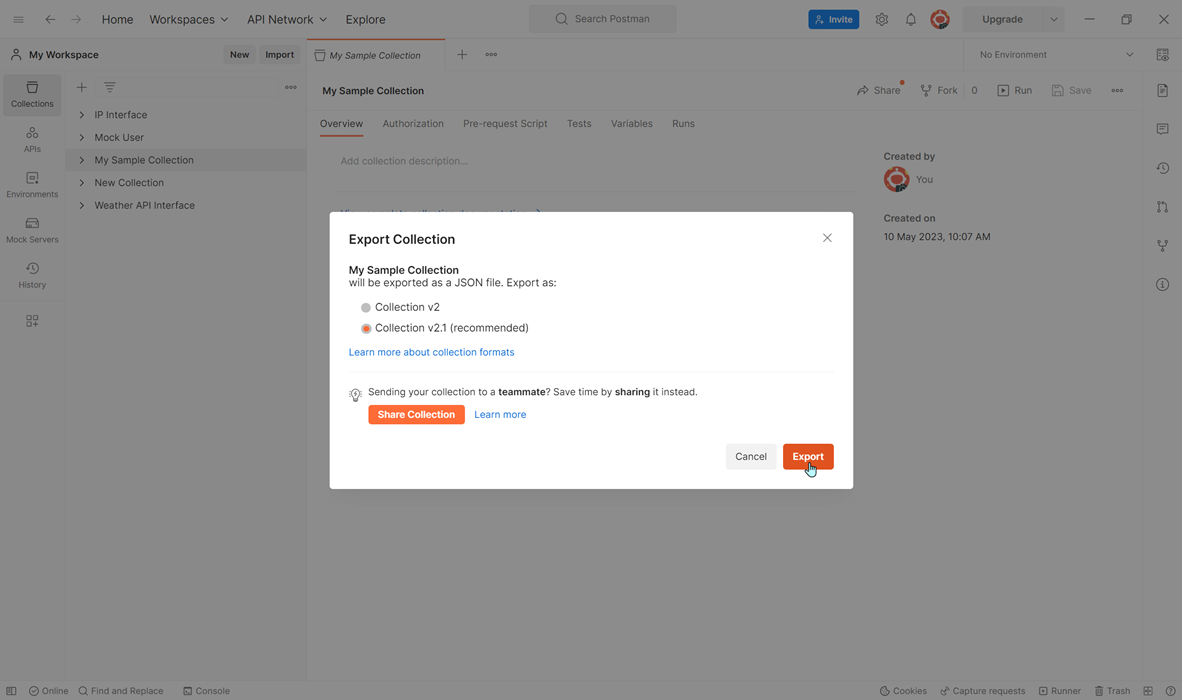
Step 3. Choose the location on your computer where you want to save the exported file.
Step 4. Click "Save" to export the collection.
Export Postman All Collection
In Postman, accessing the Data tab via Settings allows you to export all Collections, Environments, Globals, and Header Presets into a single zip file.
Navigate to Settings > Data> Request Date Export within the app. Upon selecting "Export Data," you'll be directed to an area where you can download all your Postman workspace data.

You'll receive an email notification when the data is ready for download. Depending on the data size, refreshing the page will display the download status until the Download button appears for retrieval.
Alternative Method: Import Postman Collection in Apidog
Step 1. Log into Apidog, select "Settings" from the left menu, and then select "Import " to import the exported file as displayed in the image.
Step 2. Select "Postman" and upload file from downloads. In the latest version of Apidog 2.4.9, you can import Postman data, including one `collection` and multiple `environments` in a single import.
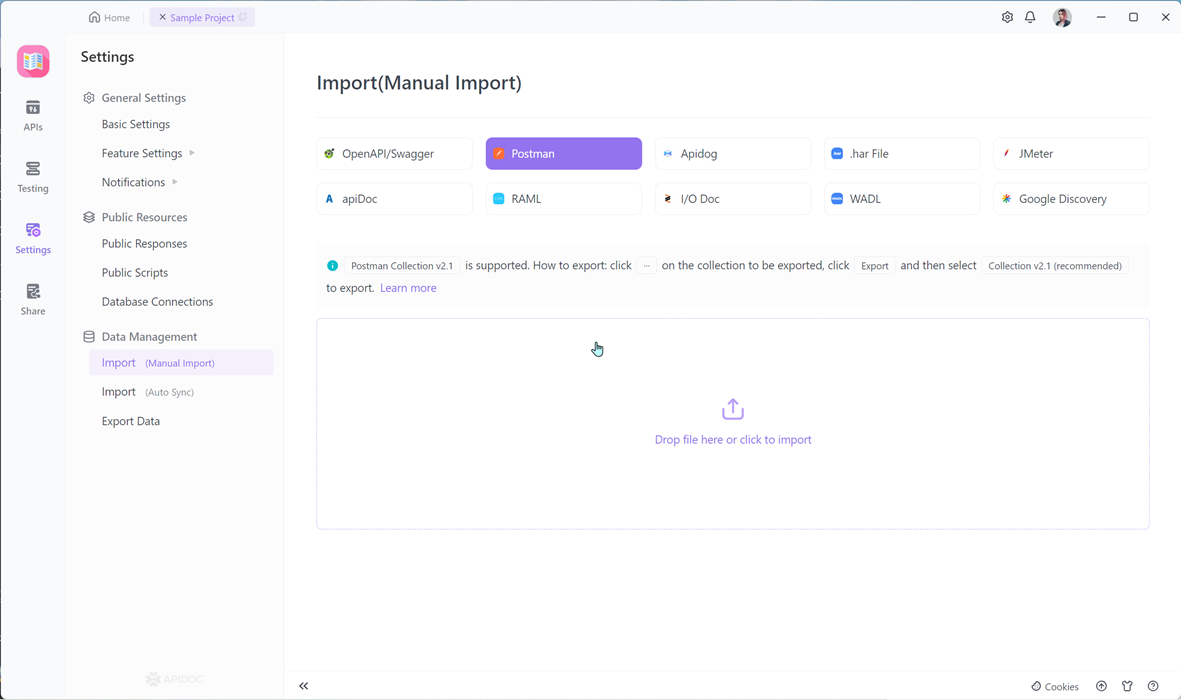
Step 3. Upload output data source from Postman. Click “Confirm” as displayed below.

Step 4. After importing your Postman collection into Apidog, you can easily manage it.
You'll have full access to your requests and can modify them as needed. Additionally, requests can be organized into folders, making it easier to navigate through your collection. Overall, Apidog provides a user-friendly interface for managing and organizing collections.

Conclusion
Importing a Postman collection into Bruno doesn’t have to be a painful experience. With the right troubleshooting steps, you can overcome most issues, whether they’re related to compatibility, file size, or configuration differences.
But let’s be real—if you’re finding yourself constantly battling with these kinds of issues, it might be time to make the switch to a more user-friendly tool like Apidog. After all, why put up with being squeezed for money when there’s a better option out there?



